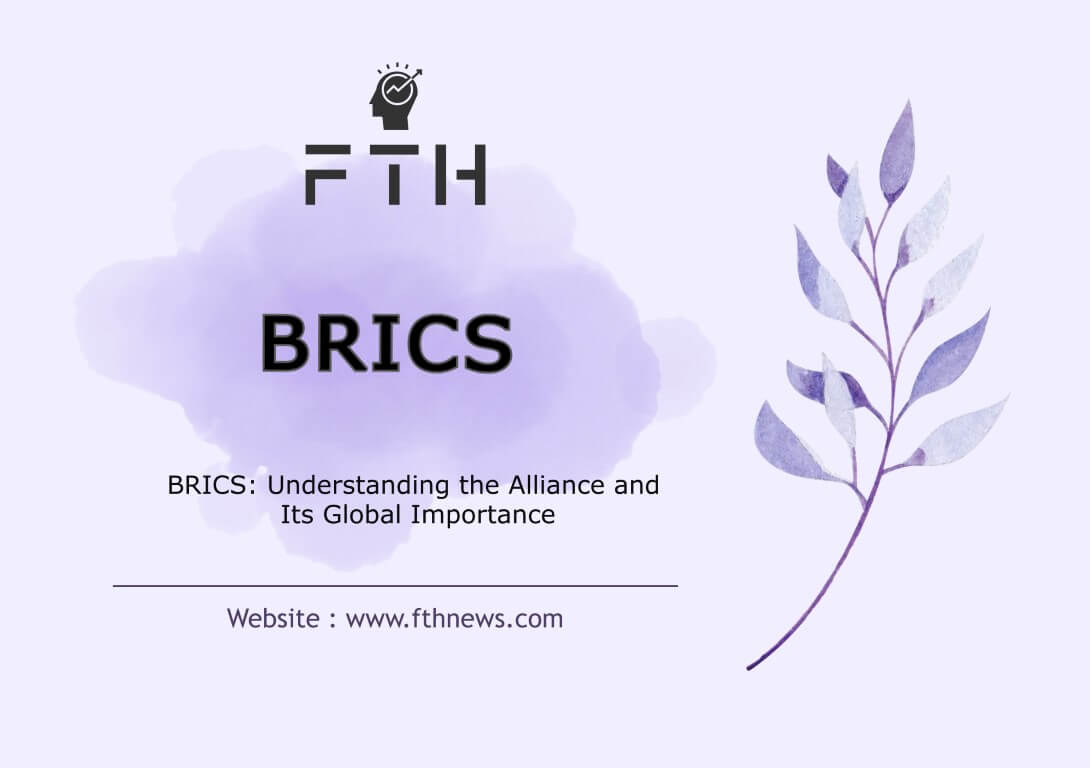
BRICS: Understanding the Alliance and Its Global Importance
BRICS, a term formed by combining the initials of Brazil, Russia, India, China, and South Africa, isn’t just an acronym; it represents a transformative force reshaping the world’s economic and geopolitical landscape. In the 21st century, these nations have emerged as key players, challenging traditional power structures dominated by the West. From economic prowess to strategic collaboration, BRICS is not merely a group of nations; it’s a powerhouse alliance with the potential to redefine global influence. Let’s embark on a journey to unravel the significance of BRICS and understand why it has become a focal point in discussions about the future of our interconnected world.
What is BRICS?
BRICS is a coalition of five countries recognized for being the fastest-growing “emerging” economies at the turn of the century. However, today, at least one of these countries, China, is considered an established economic power rather than an emerging one.
The term “BRICS” is an acronym derived from the first letters of the member countries’ names in English—Brazil, Russia, India, China, and South Africa.
The initial meeting of BRICS foreign ministers from China, India, Brazil, and Russia took place on the sidelines of the United Nations General Assembly in 2006. The first official summit was subsequently held in Russia in 2009. South Africa joined the trade council the following year, solidifying the group of five nations. Since then, an annual summit has taken place, rotating among the member countries.
Understanding BRICS
BRICS is a transcontinental union comprising nations experiencing rapid economic development. Member countries collaborate on various fronts, including trade, industrial development, investment, food security, research and development, cultural exchanges, and tourism.
Economically, BRICS adopts a different perspective compared to European countries and the United States. The coalition believes that embracing multilateralism is the most effective way to reap benefits for the majority. The name “BRICS” is an amalgamation of the initial letters of the member countries’ names.
The member countries are as follows:
- B (Brazil) – Brazil
- R (Russia) – Russia
- I (India) – India
- C (China) – China
- S (South Africa) – South Africa
Together, these nations represent more than 3 billion people, approximately 40% of the world’s population. They contribute 30% to the global GDP and account for 17% of global trade. Notably, BRICS competes closely with the G7 industrialized countries, as European nations and the United States are not part of this union.
Moreover, BRICS expresses openness to admitting new members from developing countries. Countries such as Iran and Argentina have expressed interest in joining this coalition. Importantly, BRICS extends its influence beyond financial and commercial matters, actively participating in political affairs and global peace initiatives.
One notable achievement of BRICS is the establishment of the Development Bank and Foreign Exchange Reserve. These institutions aim to assist impoverished countries and address political and economic challenges arising from global crises.
History and Formation of BRICS
The seeds of BRICS were sown during the 61st session of the United Nations General Assembly when ministers from China, India, Russia, and Brazil initiated discussions about forming this strategic alliance. Subsequently, four additional meetings were convened in various parts of the world to bolster and advance the establishment of this alliance.
In 2009, the inaugural meeting took place in Russia, gathering representatives from Brazil, Russia, China, and India. The primary focus of this meeting centered around the reform and enhancement of financial and commercial systems, with a broader emphasis on economic issues. The belief held by this coalition was that a fundamental transformation of the global financial system was imperative for it to become stable and robust.
During this meeting, deliberations also delved into the devaluation of the dollar, exploring the potential ramifications on the world economy. As subsequent meetings unfolded, discussions expanded, and concrete steps were taken to implement the proposed changes.
These gatherings, featuring active participation from member countries of the coalition, aimed at translating proposed goals into practical initiatives with tangible outcomes. The fourth meeting, convened on March 21, 2011, in New Delhi, India, marked a significant milestone in the union’s progression.
Key highlights from the fourth meeting included the proposal for the establishment of the South-South Development Bank. This initiative sought to decrease reliance on Western countries (Europe and the United States) and the dollar, emphasizing the importance of fostering increased trade among the member states of the Union.
The collaborative efforts of BRICS in formulating these proposals underscore the union’s commitment to addressing global economic challenges and fostering a more equitable and resilient international financial system.
Why is BRICS Important?
The significance of BRICS stems from the remarkable attributes of its member countries:
Global Size and Influence:
Russia, China, Brazil, and India hold the positions of the first, third, fifth, and seventh largest countries in the world, respectively.
China and India, the most populous nations globally, collectively account for over two billion people.
With the exception of South Africa, the other four countries rank among the top seven in terms of land area and feature in the top ten both in population and GDP.
Military Strength:
Three of the five largest armies in the world, based on active personnel, belong to BRICS countries.
Economic Impact:
Collectively, BRICS countries represent approximately 40% of the world’s population, a quarter of the global gross national product, and about a third of the world’s land.
Despite South Africa’s relatively smaller size among BRICS nations, it is the only African member and holds the position as Africa’s second-largest economy by GDP (or third by alternate estimates).
Johannesburg, the largest and wealthiest city in South Africa, is widely recognized as the economic capital of Africa.
Production Powerhouse:
BRICS countries are vital contributors to global production, playing a crucial role in the manufacturing of goods, services, and raw materials.
Projections indicate that they are poised to become the world’s largest producers in the near future.
Natural Resources and Reserves:
BRICS nations boast extensive and diverse reserves of natural and underground resources, encompassing energy and rare elements.
Abundant Labor Force:
These countries benefit from abundant and cost-effective labor, contributing to their economic competitiveness.
Cost-Effective Production:
BRICS countries maintain a low cost of production, making them formidable players in the global economic landscape.
In essence, BRICS is a powerhouse collective, not only in terms of population, economic output, and military strength but also as key contributors to global production and holders of substantial natural resources. The collaborative potential of these nations positions BRICS as a significant player in shaping the future of the world economy.
Countries Participating in the Recent BRICS Meeting
In the most recent summit, Chinese President extended invitations to several nations, broadening the scope of participation. Invited countries included Algeria, Egypt, Indonesia, Kazakhstan, Senegal, Uzbekistan, Cambodia, Ethiopia, Fiji, Malaysia, and Thailand. Notably, Pakistan expressed its willingness to participate, but participation was hindered by an objection from one country, ostensibly India.
This move reflects a growing interest in expanding the collaboration beyond the core BRICS nations. Previously, countries such as Turkey, Bangladesh, Mexico, Nigeria, Syria, Egypt, and Nigeria have also expressed their eagerness to join the BRICS alliance.
The inclusive nature of these invitations underscores a willingness to engage with a diverse range of nations and potentially broaden the impact and influence of the BRICS coalition on the global stage.
Can BRICS Challenge the Dominance of the Dollar?
The geopolitical landscape is witnessing an expansion of differences between the United States and Russia, while China emerges as a formidable economic rival striving to diminish the influence of the dollar in its trade transactions. Agreements forged by China with nations like Russia, Brazil, and France underscore a shift toward conducting trade in Yuan, China’s currency.
Moreover, the combined Gross Domestic Product (GDP) of BRICS member countries now surpasses that of the Group of Seven (G7) wealthy nations. In response, BRICS nations are contemplating the introduction of an international currency, signaling a strategic move away from reliance on the dollar for their commercial transactions.
Compounding these dynamics are challenges faced by the US dollar, including crises in the American banking system, rising interest rates, escalating inflation, and an increasing national debt. Notably, some countries, such as Saudi Arabia, have been reducing their dollar reserves, casting doubt on the dollar’s enduring status as the world’s primary currency.
However, according to Niall Ferguson, a Stanford University professor, the euro poses a more immediate challenge to the dollar than the Chinese yuan. The euro has accounted for 20% of global foreign exchange reserves and 22% of international exchanges over the past two decades. In contrast, the yuan comprises only 2.7% of foreign exchange reserves and 1.7% of global transactions.
Despite these challenges, the resilience, liquidity, and flexibility of the American economy suggest that the decline of the dollar may not be imminent. The United States holds about $35 trillion in foreign investments based on other currencies, which could see increased returns if the dollar were to falter—a scenario that could pose difficulties for other nations.
BRICS and the European Union
In certain aspects, BRICS and the European Union share commonalities as cooperative unions aimed at mutual upliftment. However, significant differences exist among BRICS member countries, including diverse resources and geographical locations spanning Asia, Eurasia, Africa, and South America. While this diversity enhances the group’s capacity and resource pool, it also contrasts with the European Union, which comprises countries with more shared characteristics.
BRICS has evolved into a force to be reckoned with in global institutions like the International Monetary Fund, challenging traditional power structures. The union is growing in political and security influence, viewing the European Union not as a competitor but as a potential partner in shaping global politics and security.
The European Union recognizes the economic and political opportunities within BRICS and emphasizes the need to enhance trade interactions with these member countries. Although bilateral trade occurs, studies reveal that BRICS member countries export more to the European Union than the reverse, signaling economic favorability toward the BRICS nations.
Goals of BRICS Member States
The BRICS alliance brings together member countries, each with unique capacities across different sectors, fostering collaboration to bolster individual and collective objectives. This cooperative approach aims to address deficiencies within member nations while leveraging strengths to contribute to the progress of the entire union and, by extension, other nations. Currently, nations like Iran and Argentina express interest in joining BRICS, each with their distinct goals. Here, we explore the objectives of the existing member countries.
China:
China, boasting the title of the world’s second-largest economy and the leading producer of goods, is a rapidly advancing emerging economy. Faced with opposition from Western nations, particularly the United States, China seeks allies and partners to challenge Western dominance economically and politically. Collaborating with BRICS, China aspires to shift global power dynamics away from the West. With its swift economic growth and the support of this union, China aims to potentially surpass the United States as the world’s largest economy.
Russia:
After the economic challenges following the collapse of the Soviet Union, Russia grappled with issues and faced restrictions due to geopolitical tensions, such as the war with Ukraine. However, joining BRICS allowed Russia to overcome some economic hurdles and regain international recognition. Endowed with significant reserves, including gold and natural resources like oil and gas, Russia has strengthened its position globally, challenging the Western world order. BRICS provides Russia with a platform to challenge Western dominance and reduce its dependence on Western institutions.
India:
India, the world’s second most populous country, has leveraged its membership in BRICS to make strides in economic and technological domains. Through collaboration with other BRICS members, India has experienced progress in economic affairs and technology. Effective management and the potential of the alliance have allowed India to capitalize on technological advancements and economic growth.
Brazil:
Historically facing economic challenges, Brazil has undergone a transformative journey. By joining BRICS and harnessing the group’s collective capabilities, Brazil managed to increase domestic production and achieve significant progress in agriculture, animal husbandry, and technology. In 2013, Brazil secured the recognition as the sixth-largest economy globally, surpassing established economies like England.
South Africa:
South Africa, the most recent addition to BRICS, sought membership to drive national development, enhance international visibility, stimulate economic growth, and increase GDP. Post-joining, South Africa experienced growth in GDP, domestic investment, exports, and the private sector. The inclusion of South Africa prompted the transition from BRIC to BRICS, reflecting the addition of the “S” from the country’s name.
In essence, BRICS serves as a platform for member countries to collaborate, overcome individual challenges, and collectively challenge the traditional dominance of the West. The union represents a strategic alliance aimed at reshaping global power dynamics through economic, technological, and political cooperation.
Final Word
While current global power dynamics are dominated by the United States and European countries, emerging economies refuse to accept this as a permanent status quo. BRICS, a union of nations experiencing rapid economic development, seeks to redistribute global power by leveraging collective strengths.
Individually, no single country possesses enough influence to challenge the political and economic dominance of the West. However, by uniting nations with diverse potentials, BRICS aims to present a formidable challenge to Western power concentration. This article has endeavored to introduce BRICS and provide a comprehensive examination of the alliance from various perspectives.
Feel free to share any additional sections for refinement or ask for further elaboration on specific points!
FAQ
BRICS, an acronym for Brazil, Russia, India, China, and South Africa, is a coalition of major emerging economies. Formed with the purpose of fostering economic cooperation and challenging Western dominance, BRICS aims to reshape global power dynamics through strategic collaboration and mutual development initiatives.
While BRICS collectively wields significant economic and geopolitical influence, it falls short of the traditional definition of a superpower. Individually, member nations like China and Russia possess considerable power, but the term “superpower” typically refers to a nation with unparalleled global influence across various domains, including military, economic, and political realms. BRICS, as an alliance, is a substantial force challenging existing power structures, but it does not yet match the comprehensive influence associated with superpowers like the United States.














